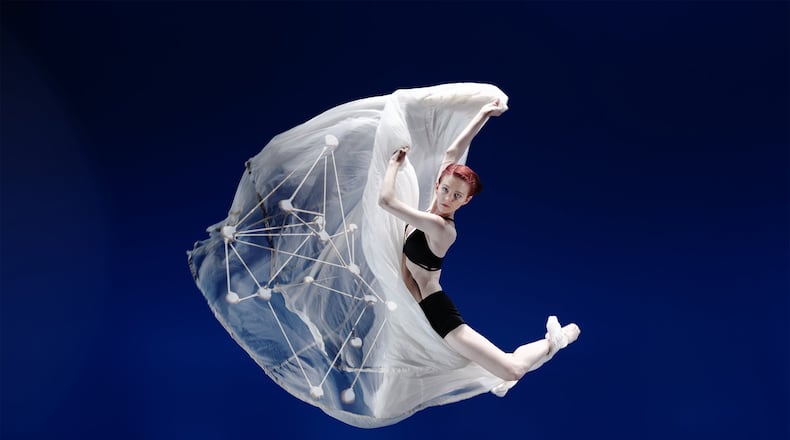In a spartan but spacious dance studio, silver-clad dancers lunge and spin to music that sounds like impulses firing through neurons in the brain. Performers climb on a geometric sculpture built of intersecting tubes. Its angles heighten the body’s architecture, and it looks like a model of brain synapses, or a rolling scaffold dreamed up by Buckminster Fuller.
The room darkens as a young dancer, perched atop the tower, opens a book, revealing white light. The sculpture starts to rotate, and as she reads, she seems freed from gravity, whirling in the space of the imagination.
The dancers are students at Kennesaw State University, preparing "Metamorphosis," a large-scale, 45-minute work on the power of knowledge to transform people's lives. Choreographed by Ivan Pulinkala, chair of KSU's dance department, "Metamorphosis" represents another transformation — renovation of a time-worn auditorium into the state-of-the-art Dance Theater.
When “Metamorphosis” premieres March 24-25, it will mark the debut of the Dance Theater at KSU’s Marietta campus, formerly Southern Polytechnic State University.
The venue will serve as performance home for KSU’s dance department and will also be available as a professionally staffed, low-cost rental to local dance companies. Potentially, it could become the city’s newest dance hub.
The dearth of available, suitably sized theaters for dance performance in Atlanta worsened when the Woodruff Arts Center sold the 14th Street Playhouse in December 2013. It was a limitation Pulinkala had faced over the years as his program grew from a handful of dance minors to a department of 120 dance majors. When the state Board of Regents announced that KSU would consolidate with Southern Poly, Pulinkala knew of the auditorium and thought it had potential.
The 450-seat, 1960s-era theater had housed campus events and local dance recitals, but had fallen into disrepair. The floor was uneven and un-sprung. Outdated lighting and sound systems barely worked, and space between the back wall and cyclorama was too narrow for dancers to cross behind it.
But it had “good bones,” Pulinkala said. Its deep stage area crossed a 40-foot wide proscenium into an audience house, steeply raked for clear sight lines. Side sections curved gently around the stage apron, creating an intimate feel.
Pulinkala and KSU dance production manager David Tatu found a model in New York City’s Joyce Theater, so well-tailored for dance that companies can tech their shows in four hours. The KSU team focused on functionality — a new light grid and sound system. They built a new proscenium arch, and leveled the stage and backstage wings, so a sprung Marley dance floor could run from wall to wall.
But none of those upgrades allowed dancers backstage to move safely from stage right to stage left.
The solution became one of the theater’s most valuable assets — the addition of an exterior corridor that enables dancers to cross unimpeded behind the stage wall. Running about 10 percent of the project’s $1 million construction budget, the passageway symbolizes KSU’s commitment to the Atlanta dance community’s talent and creativity.
Which begs the question — if you build it, will they come?
Asked if the theater’s distance from downtown Atlanta could be a detriment, Pulinkala pointed to the success of the nearby Cobb Energy Performing Arts Centre.
“If there is a space where people are producing good work, in time, it’s going to be a space people will go to,” Pulinkala said.
Douglas Scott, artistic director of Full Radius Dance, agreed, saying that a dance-dedicated venue like KSU's Dance Theater is "unheard of in Atlanta," and much-needed.
However, about 10 per cent of Full Radius’ funding comes from the City of Atlanta and Fulton County Arts Council. Both require productions they fund to take place within their jurisdictions. He would have to raise $20,000 from another source in order to use the new venue on his current budget.
Perhaps arts leaders could eventually make a case for those funders to reconsider their boundaries, Pulinkala said, especially if the theater becomes a go-to place for dance.
To that end, Pulinkala hopes to give naming rights to a private donor to fund the project’s second phase and build an endowment for KSU to produce local, national and international dance artists.
Back in the studio, 19 dancers have begun circling the spinning sculpture. They accelerate as if pulled into its tornadic core. This weekend, a 60-member student choir will join them on stage to usher in promising change.
RELATED STORIES
DANCE PREVIEW
'Metamorphosis.' 8 p.m. Kennesaw State University Dance Company with KSU Chorus. March 24-25. $15-$20, Dance Theater, Joe Mack Wilson Student Center, KSU Marietta, 1100 S. Marietta Parkway, Marietta. 470-578-6650, ticketing.kennesaw.edu; KSUDance.com.
About the Author
Keep Reading
The Latest
Featured


